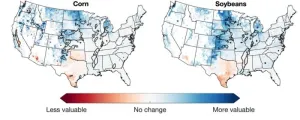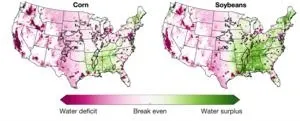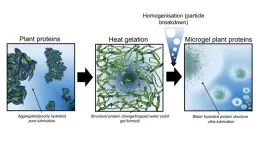(Press-News.org) With climate change, irrigating more crops in the United States will be critical to sustaining future yields, as drought conditions are likely to increase due to warmer temperatures and shifting precipitation patterns. Yet less than 20% of croplands are equipped for irrigation.
A Dartmouth-led study finds that by the middle of the 21st century under a moderate greenhouse gas emissions scenario, the benefits of expanded irrigation will outweigh the costs of installation and operation over an expanded portion of current U.S. croplands. The results show that by mid-century corn and soybeans that are currently rainfed would benefit from irrigation in most of North Dakota, eastern South Dakota, western Minnesota, Wisconsin, and Michigan. Soybean farmland that relies on rain throughout parts of Indiana, Illinois, Ohio, Kentucky, Kansas, and Oklahoma would also benefit from irrigation. The findings are published in Communications Earth & Environment, an open-access journal from Nature Portfolio.
Installing, maintaining, and running irrigation equipment comes at a significant cost to farmers, as much as $160 per acre per year. "Our work essentially creates a U.S. map of where it will make the most sense to install and use irrigation equipment for corn and soybean crops in the future," says first author Trevor Partridge, a Mendenhall Postdoctoral Fellow and research hydrologist with the U.S. Geological Survey Water Resources Mission Area, who conducted the study while working on his PhD at Dartmouth.
The High Plains region, including Nebraska, Kansas, and northern Texas, has historically been one of the most heavily irrigated areas, and was found to have the highest current economic returns for irrigation. However, the increasing costs of drought are pushing farmers to invest in irrigation throughout regions of the Corn Belt and southeastern U.S., and the long-term economic return on these investments is difficult to predict.
To conduct the cost-benefit analysis of irrigating corn and soybeans, the researchers ran a series of crop model simulations. They applied several global climate projections that span the range of potential future climates—hot and dry, hot and wet, cool and dry, cool and wet, each relative to the average climate projection—to simulate future crop growth under fully irrigated or rainfed conditions.
For each climate scenario, the crop model was run for both corn and soybeans across all cultivated areas in the U.S. The crop model simulations examined three periods: historical (1981-2010), mid-century (2036-2065), and end-of-century (2071-2100) under moderate and high greenhouse gas emissions scenarios. The simulations factored in county-level crop management and growth data from the U.S. Department of Agriculture National Agricultural Statistical Service, including planting, maturity, and harvest dates.
To determine the economic benefits of irrigating—the team calculated the additional simulated crop yield from irrigating and the corresponding increased market value that could be expected—relative to the irrigation costs, which included the electricity required to pump groundwater and distribute it over the field, and associated expenses per acre to own and operate the irrigation system.
The team investigated not only where and when it makes sense to install irrigation for corn and soybeans but also if there will be enough water to do so. They calculated the "irrigation water deficit," which is the simple difference between how much water is applied to the field relative to how much water should be available for irrigation.
The results show that by mid-century there will likely be enough water to irrigate soybeans in Iowa, Wisconsin, Ohio, and northern Illinois and Indiana, but not corn. Iowa is the largest producer of corn in the U.S. Groundwater resources for irrigation were found to be the most abundant in the southeast U.S., especially in the lower Mississippi Valley where agriculture is less intensive. However, in this region the benefits of irrigation are minimal.
"Our results suggest that there is relatively little overlap between where there is enough water to fully irrigate crops without placing additional stress on water resources and where farmers can expect the investment in irrigation to pay for itself over the long term, " says Partridge.
For example, the Ogallala Aquifer in the Great Plains is the largest aquifer in the U.S., providing water to eight states, and supports one the most extensively irrigated areas for corn and soybeans.
"The increasing benefits of irrigation, could incentivize farmers to use more water, which will place additional stress on key aquifers, including the Ogallala," says senior author Jonathan Winter, an associate professor of geography and lead of the Applied Hydroclimatology Group at Dartmouth. Prior research has shown that water is being extracted from the Ogallala Aquifer faster than it can be replenished. "There's just not enough water to continue irrigating at the current rate from the Ogallala, especially in the southern portion where groundwater levels are rapidly falling," says Winter.
With greater warming, such as end-of-century under a high greenhouse gas emissions scenario, heat stress will dominate impacts on crop yields and reduce the effectiveness of irrigation as an adaptation strategy throughout most of the U.S., especially for corn. Corn typically has a higher yield than soybean, but soybeans are more heat tolerant, don't require as much water, and have a slightly shorter growing season.
"By the end of the century, our simulations suggest that it will be more economically beneficial to irrigate soybeans than corn," says Winter. "Once irrigation is installed, we could see some places that historically grew corn switch to soybeans because it's a low-cost adaptation."
When it comes to irrigation, farmers must consider a range of complex and competing factors: previous yield performance, crop market values, energy costs, economic incentives, and seasonal weather forecasts. The researchers hope that their analysis can be used to help agricultural and water resource management policies in adapting to a warmer climate.
Partridge (tpartridge@usgs.gov) and Winter (jonathan.m.winter@dartmouth.edu) are available for comment. Anthony Kendall and Bruno Basso at Michigan State University, Lisi Pei at Michigan State University and Georgia Institute of Technology, and David Hyndman at the University of Texas at Dallas also contributed to the study.
###
END
Irrigating more US crops by mid-century will be worth the investment
Researchers conduct a cost-benefit analysis of expanded irrigation of corn and soybeans under future climate
2023-08-14
ELSE PRESS RELEASES FROM THIS DATE:
New statement urges engaging patients in their care, collaborating on treatment decisions
2023-08-14
DALLAS, Aug. 14, 2023 - A new American Heart Association scientific statement highlights evidence that supports shared decision-making, a term that describes the process of ensuring patients have the knowledge and tools to make decisions about their health in collaboration with their professional health care team. The statement publishes today in the American Heart Association’s flagship, peer-reviewed journal Circulation.
More than 100 trials have demonstrated that shared decision-making ...
Making plant-based meat alternatives more palatable
2023-08-14
New colloidal technique could give a juicy sensation without adding fat
Switch to plant-based diets needed to hit climate change targets
One of the biggest obstacles to the uptake of plant-based alternatives to meat is their very dry and astringent feel when they are eaten.
Scientists, led by Professor Anwesha Sarkar at the University of Leeds, are revolutionising the sensation of plant proteins, transforming them from a substance that can be experienced as gloopy and dry to one that is juicy and fat like.
And the only substance they are adding to the plant proteins is water.
Plant protein microgels
To ...
3D-printed vegan seafood could someday be what’s for dinner (video)
2023-08-13
SAN FRANCISCO, Aug. 13, 2023 — In the refrigerated grocery store aisle, meat alternatives greatly outnumber plant-based seafoods. But more mock seafood options are needed because of unsustainable fishing and aquaculture practices, which can deplete the supply and harm the environment. Today, researchers present a new approach for creating desirable vegan seafood mimics that taste good, while maintaining the healthful profile of real fish. They 3D-printed an ink made from microalgae protein and mung bean protein, and their proof-of-concept calamari rings can even be air-fried for a quick, tasty snack.
The researchers will present their results at the fall meeting of the American ...
ORNL buildings researchers earn top ASHRAE honors
2023-08-12
Kashif Nawaz and Mahabir Bhandari, building technologies researchers at the Department of Energy’s Oak Ridge National Laboratory, were recognized for research achievements in support of ASHRAE during the 2023 annual conference of the national heating, refrigerating, and air-conditioning engineering society.
Nawaz, a distinguished researcher and head of ORNL’s Buildings Technologies Research Section, received the Crosby Field Award, which honors the highest-rated paper presented before a technical session, a symposium or poster session ...
Raising awareness of Long Covid ‘blue legs’ symptom
2023-08-12
An unusual case of a Long Covid patient’s legs turning blue after 10 minutes of standing highlights the need for greater awareness of this symptom among people with the condition, according to new research published in the Lancet.
The paper, authored by Dr Manoj Sivan at the University of Leeds, focuses on the case of one 33-year man who developed with acrocyanosis – venous pooling of blood in the legs.
A minute after standing, the patient’s legs began to redden and became increasingly blue over time, with veins becoming more prominent. After 10 minutes the colour was much more pronounced, with the patient ...
For labrum tears, regrowth rather than repair
2023-08-12
Tears to the glenoid labrum—cartilage tissue that lines the shoulder where the arm joins—can be repaired with arthroscopic surgery, which significantly weakens the joint and involves a lengthy recovery.
Liping Tang, a bioengineering professor at The University of Texas at Arlington, is developing a new method to repair labrum tears that would enable the body to regenerate tissue to completely reattach the sides of the tear. He recently received a five-year, $2.1 million grant from the National Institutes of Health’s National Institute of Arthritis and Musculoskeletal and Skin Diseases for the research, which would improve the current standard of care ...
Call for papers: Special theme issue: Artificial intelligence (AI) and ChatGPT in Asian and Pacific Islander (API) health
2023-08-11
Asian/Pacific Island Nursing Journal (APINJ) Editor-in-Chief: Hyochol (Brian) Ahn, PhD, MSN, MS-ECE, MS-CTS, APRN, ANP-BC, FAAN and guest editor Shu-Fen Wung, Ph.D., RN, ACNP-BC, FAAN welcome submissions to a special theme issue examining "Artificial Intelligence (AI) and ChatGPT in Asian and Pacific Islander (API) Health."
Generative AI, like ChatGPT, can have many applications in health care and medicine, particularly in addressing the unique needs and challenges faced by API communities. Potential topics related to the use of generative AI in health care and nursing care specific to API health that we ...
SLU ethicists, leading scholars publish guidance for parents, physicians making medical decisions for children
2023-08-11
ST. LOUIS – How should others make decisions for pediatric patients?
For decades, there has been debate in academic literature about the ethical principles that govern medical decision-making for children. In response to this, a group of leading scholars in pediatric ethics participated in a June 2022 symposium, “Best Interests and Beyond: Standards of Decision Making in Pediatrics,” at Saint Louis University. Over the course of three days, the 17 scholars debated one question – in the context of U.S. pediatric care, what moral precepts ought to guide parents and clinicians in medical decision-making for children?
A group of ...
Hundred-year storms? That's how long they last on Saturn.
2023-08-11
The largest storm in the solar system, a 10,000-mile-wide anticyclone called the Great Red Spot, has decorated Jupiter's surface for hundreds of years.
A new study now shows that Saturn — though much blander and less colorful than Jupiter — also has long-lasting megastorms with impacts deep in the atmosphere that persist for centuries.
The study was conducted by astronomers from the University of California, Berkeley, and the University of Michigan, Ann Arbor, who looked at radio emissions from the planet, which come from below the surface, and found long-term disruptions in the distribution ...
New concussion headset shows when it's safe to return to play
2023-08-11
A new digital headset designed to measure alterations in brain function could change decisions about how quickly an athlete is ready to return to play after a concussion. In an evaluation of the device, UC San Francisco researchers found it revealed brain changes even in athletes whose concussion symptoms had gone away, suggesting they could be playing too soon.
Although not yet approved by the Food and Drug Administration (FDA), the device could fill an important niche among athletes, clinicians, trainers and coaches, who are concerned about the long-term effects of repeated sports-related concussions. These include chronic traumatic encephalopathy, ...
LAST 30 PRESS RELEASES:
Eye for trouble: Automated counting for chromosome issues under the microscope
The vast majority of US rivers lack any protections from human activities, new research finds
Ultrasound-responsive in situ antigen "nanocatchers" open a new paradigm for personalized tumor immunotherapy
Environmental “superbugs” in our rivers and soils: new one health review warns of growing antimicrobial resistance crisis
Triple threat in greenhouse farming: how heavy metals, microplastics, and antibiotic resistance genes unite to challenge sustainable food production
Earthworms turn manure into a powerful tool against antibiotic resistance
AI turns water into an early warning network for hidden biological pollutants
Hidden hotspots on “green” plastics: biodegradable and conventional plastics shape very different antibiotic resistance risks in river microbiomes
Engineered biochar enzyme system clears toxic phenolic acids and restores pepper seed germination in continuous cropping soils
Retail therapy fail? Online shopping linked to stress, says study
How well-meaning allies can increase stress for marginalized people
Commercially viable biomanufacturing: designer yeast turns sugar into lucrative chemical 3-HP
Control valve discovered in gut’s plumbing system
George Mason University leads phase 2 clinical trial for pill to help maintain weight loss after GLP-1s
Hop to it: research from Shedd Aquarium tracks conch movement to set new conservation guidance
Weight loss drugs and bariatric surgery improve the body’s fat ‘balance:’ study
The Age of Fishes began with mass death
TB harnesses part of immune defense system to cause infection
Important new source of oxidation in the atmosphere found
A tug-of-war explains a decades-old question about how bacteria swim
Strengthened immune defense against cancer
Engineering the development of the pancreas
The Journal of Nuclear Medicine ahead-of-print tip sheet: Jan. 9, 2026
Mount Sinai researchers help create largest immune cell atlas of bone marrow in multiple myeloma patients
Why it is so hard to get started on an unpleasant task: Scientists identify a “motivation brake”
Body composition changes after bariatric surgery or treatment with GLP-1 receptor agonists
Targeted regulation of abortion providers laws and pregnancies conceived through fertility treatment
Press registration is now open for the 2026 ACMG Annual Clinical Genetics Meeting
Understanding sex-based differences and the role of bone morphogenetic protein signaling in Alzheimer’s disease
Breakthrough in thin-film electrolytes pushes solid oxide fuel cells forward
[Press-News.org] Irrigating more US crops by mid-century will be worth the investmentResearchers conduct a cost-benefit analysis of expanded irrigation of corn and soybeans under future climate








